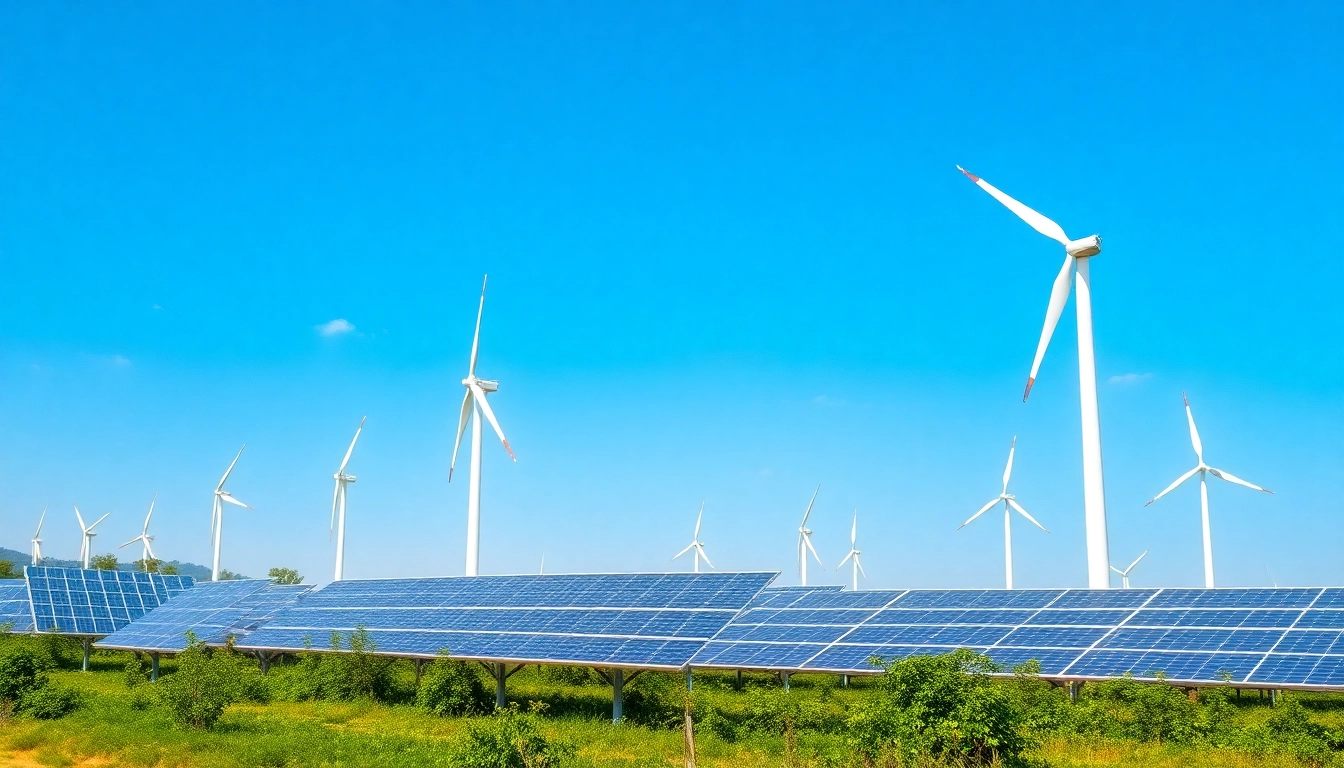Understanding Renewable Energy: Fundamentals and Types
Renewable energy is fundamentally defined as energy derived from natural sources that are replenished at a rate faster than they are consumed. Such sources include sunlight, wind, water (hydropower), geothermal heat, and bioenergy. This characteristic makes renewable energy a sustainable alternative to traditional fossil fuels, which are finite and contribute significantly to environmental pollution and climate change. Globally, the shift toward renewable energy is driven by the urgent need to reduce greenhouse gas emissions, improve air quality, and ensure energy security for future generations. In India, renewable sources are expected to contribute around 40% of the country’s power generation capacity by 2030, aligning with global climate commitments and national sustainability targets.
Empowering this transition, India has undertaken significant policy reforms and infrastructure investments to harness the potential of renewables. For instance, solar, wind, and hydropower projects have witnessed rapid expansion, supported by advancements in technology, declining costs, and favorable government policies. This evolution is supported by comprehensive research and market analysis, such as that provided by JMK Research & Analytics, which offers invaluable insights into project viability, regulatory frameworks, and emerging trends within the renewable energy sector.
For more insights on this transformative energy landscape, visit renewable energy and explore data-driven strategies to incorporate sustainable power sources into your operations or investments.
Indian Market Dynamics and Policy Landscape for Renewable Energy
Government Initiatives and Regulatory Frameworks
The Government of India has pioneered a robust policy environment to accelerate the deployment of renewable energy. Initiatives such as the National Solar Mission, aimed at achieving 100 GW of solar capacity by 2022, exemplify the country’s commitment. Regulatory frameworks have evolved to facilitate grid integration, incentivize private sector participation, and promote green financing. Recently, states like Rajasthan have adopted progressive measures; in particular, Rajasthan’s Green Open Access (GEOA) rules now mandate Battery Energy Storage Systems (BESS) for projects over 5MW, reinforcing the importance of storage in renewable integration.
These policies not only foster a conducive environment for project development but also specify standards to ensure grid stability and environmental standards are maintained. The Central Electricity Regulatory Commission (CERC) has also taken steps to enhance market liquidity, notably by greenlighting virtual Power Purchase Agreements (VPPAs), which revolutionize renewable project financing and supply contracts.
Market Challenges and Opportunities for Investors
Despite promising prospects, investing in India’s renewable energy sector faces challenges such as supply chain constraints, tariffs fluctuations, and regulatory delays. However, these hurdles are offset by opportunities including declining costs, technological innovations, and supportive government schemes. The current landscape is also witnessing innovative project structures like hybrid wind-solar systems and energy storage solutions, opening new avenues for diversification and risk mitigation.
State-level Policies and Innovations in Renewable Projects
Regional policies significantly influence project execution. For example, recent reforms in Rajasthan have doubled the permissible plant size relative to contract demand and mandated BESS integration. Other states are exploring land acquisition reforms, incentive schemes, and customized tariffs to attract private investment. These localized policies often serve as pilot programs or models for national scaling.
Technologies and Innovations Driving Renewable Energy Growth
Emerging Solar and Wind Technologies in India
Indian renewable energy development is driven by technological innovations such as bifacial solar modules, floating solar systems, and taller wind turbine towers. Bifacial solar panels have shown to improve energy yield by capturing sunlight from both sides, thereby reducing Levelized Cost of Energy (LCOE). Floating solar installations optimize land use in water bodies, reducing evaporation and cooling panels to boost efficiency. Wind turbines are evolving with increased hub heights, allowing access to higher wind speeds, particularly in the Indian coastal regions.
Role of Energy Storage and Grid Integration
Energy storage is pivotal to manage intermittent renewable sources effectively. Recent initiatives, such as Rajasthan’s mandates and India’s grid-scale tender evolution, emphasize large-scale battery storage to ensure grid stability and dispatchability. Technologies include lithium-ion, flow batteries, and emerging solid-state options. Advanced grid management systems—integrating real-time data analytics and AI—enable better load balancing, reserve management, and peak shaving, thereby enhancing renewable integration.
Digital Solutions and Data Analytics for Optimizing Renewable Assets
Data-driven decision-making is transforming operations. Smart sensors, IoT devices, and AI-powered analytics optimize resource assessment, predictive maintenance, and performance monitoring. Platforms like JMK Research’s online portals compile project data, policy updates, and market intelligence, providing stakeholders with actionable insights. These digital solutions streamline investment decisions, reduce operational costs, and improve overall project efficiency.
Strategies for Businesses and Governments to Accelerate Adoption
Strategic Planning and Investment Opportunities
Businesses should undertake comprehensive feasibility studies to evaluate project economics, considering technological innovations, policy incentives, and market trends. Forward-looking strategies include investing in hybrid renewable systems and storage to mitigate intermittency issues. Investors can leverage virtual PPAs, which offer flexibility and risk mitigation, especially in a nascent but evolving policy environment.
Partnerships, Policy Advocacy, and Capacity Building
Collaborative ecosystems involving government agencies, private sector players, and research institutions are essential. Public-private partnerships (PPPs) help bridge finance gaps and facilitate technology transfer. Advocacy for streamlined approval processes and favorable tariffs enhances project bankability. Capacity building through skill development programs ensures adequate human resources for the renewable energy rollout.
Measuring Impact: Performance Metrics and Sustainability Goals
Effective measurement frameworks incorporate metrics such as capacity factor, Levelized Cost of Energy (LCOE), carbon abatement per unit of energy, and social impact indicators. Alignment with global sustainability standards, such as the UN Sustainable Development Goals (SDGs), amplifies stakeholder commitment. Continuous monitoring and transparent reporting foster trust and facilitate continuous improvement.
Case Studies and Success Stories in Renewable Energy Deployment
Leading Projects Transforming India’s Renewable Sector
One notable example is Rajasthan’s recent mandate requiring Battery Energy Storage Systems (BESS) for open access projects exceeding 5MW. This regulation marks a strategic move to enhance grid stability while maximizing renewable capacity deployment. Another success is the rapid growth of rooftop solar, which has been hampered by policy lag but holds immense potential due to India’s vast domestic rooftops, as detailed in comprehensive reports by JMK Research. Such projects demonstrate the effectiveness of policy innovation coupled with technological adaptation.
Innovative Business Models and Private Sector Contributions
Private sector giants like MG Motor with MG Windsor EV have spearheaded electric mobility—integrating renewable energy into transportation. Their initiatives exemplify how corporates are adopting sustainable practices, from deploying EV charging infrastructure powered by renewable energy to developing EV models aligned with the country’s clean energy goals. Similarly, virtual Power Purchase Agreements (VPPAs) are gaining ground as flexible on-demand supply contracts that cater to corporate sustainability commitments, attracting substantial investment flows.
Lessons Learned and Future Roadmap for Stakeholders
Successful deployment hinges on addressing infrastructure constraints, regulatory clarity, and financial viability. Ensuring robust grid integration, incentivizing local manufacturing, and fostering innovation in energy storage are critical steps. Future policies should emphasize scalable models, support R&D, and incentivize community participation. Stakeholders must prioritize data transparency, continuous capacity building, and fostering collaborative innovation to sustain the momentum of India’s renewable energy journey.













